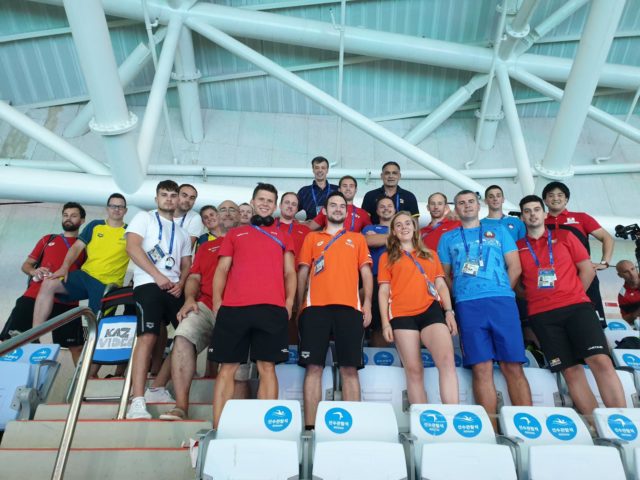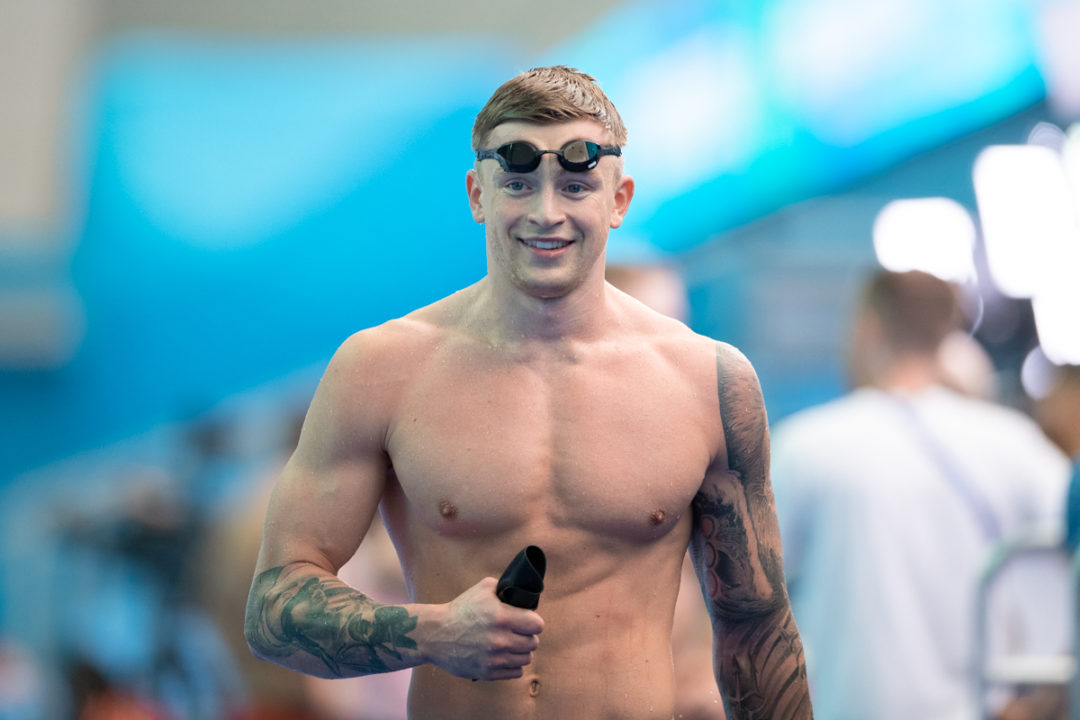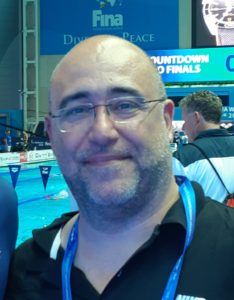Adam Peaty has a secret?
The history of technical evolution in the swimming technique usually results from a dynamic balance between what every coach, team or federation does and what it is possible to learn from the other athletes. Every main competition is a great opportunity to watch the other swimmers at work and to study the different technical solutions they adopted.
The analyst
Most of the time the differences concern training, strength and power! Sometimes it is all about some new technical solutions… but other times it is not so clear.
That’s the time when you have only one possible solution: call your “Analyst!”
The analyst is the man who lives backstage. You can usually meet him before the competition, but you will never see him during the competition. Sometimes you can see him running to his hotel carrying all his equipment.
He is always hidden in the upper part of the stand. Sometimes you hear him speaking or yelling to his camera and computer, and for sure he is the one screaming “SIT DOWN….” to the people in front of him.
But that is another story for another time. In short, every coach and every athlete at the elite levels of swimming consider the analyst as their Jiminy Cricket, always ready to give them the right advice because supported by precise, indisputable technical data. The analyst is not afraid of any question!

The Analysts! Courtesy of Stefano Nurra
- Can you tell me how to win the race?
- Why this athlete is faster than mine?
- From the heat to the semifinal I must gain 1 second in 100m, can you tell me how?”
These are the most frequent questions the analyst is usually asked, sometimes hoping for the magic wand.
Bicycle vs Motorbike?
At the moment there are few athletes who are faster than the others, but only one of them is able to leave all the others far behind. It is as if he rode a motorbike while all the others are only using a bicycle.
This is Adam “the Rider” Peaty.
Above all, in long course the gap between him and the others is huge in the 50 and 100 meters breaststroke.
It’s not easy to find the right answers to explain this miracle: the analysis of laps, splits, stroke length and stroke rate shows us that he is surely faster than the others, but the results of time are not the only thing we have to understand.
It is important to explain “why” and “how” all this is possible.
Data collection
To better understand the differences between Adam Peaty and all the other swimmers I tried a kind of analysis different from the race analysis:
The “Coordination Timing Evaluation.”
I timed all phases of the pull and the kick and I synchronized pull and kick including the gliding phase. I measured the athletes in the second and in the fourth 25 meters. The values I am showing are the average of the three cycles. The report states the time and the percentage of every phase in the cycle. One of the main parameters is the glide time and percentage.
I timed three phases for the pull:
- propulsive phase – from the catch to the beginning of the recovery.
- recovery – from the beginning of the recovery to the extension of the arms
- passive phase (a.k.a. the glide) – from the extension of the arms to the next catch
Four phases for the kick
- Recovery phase – from the flexion of the knees to the start of propulsive phase
- Propulsive phase – from the beginning to the end of the propulsive phase
- Passive phase – from the end of the propulsive phase to the next recovery phase
- Kick delay – I also timed the delay between pull and kick, stroke rate and tempo, stroke length, speed and of course the glide (value and percentage).
I analyzed the incredible world record Adam Peaty achieved in the 2nd semifinal in 100 meters breaststroke in Korea last summer, and as not a lot of people are used to this kind of analysis, I analyzed also all the other swimmers in this event, in order to compare the data collected.
The secret
These data show us something very interesting and help us explain Adam Peaty’s incredible skill. Moreover, a careful reading of the data shows us what the real difference between Peaty and the rest of the world is.
First of all, let’s consider the passive glide time as a percentage of the full stroke cycle: Adam Peaty glides more than any other swimmer.
This value is crucial if we consider his stroke rate, the highest in this semifinal and in general the highest in the world. Normally when the stroke rate increases the glide decreases. In my opinion this is the real difference in Peaty.
Let’s try and understand how he can reach this kind of gliding and power!
With a careful reading of the timing of the pull and kick phases we can observe that Peaty’s pull recovery is the fastest. If we consider the propulsive kick phase, Peaty is absolutely faster than any other swimmer of the group. Both parameters are very effective for the propulsion.
Video courtesy Of Stefano Nurra
The pull
The way Peaty carries out the pull is absolutely amazing. He can reduce the time of the recovery without wasting any propulsion: this is the reason why he has more time to glide. Some underwater videos online show us how Adam Peaty is able to direct the recovery just forward, reducing the front drag as much as possible.
Another interesting detail is the proportion between all the phases of the pull.
Peaty’s recovery is shorter than the propulsive pull. He inverted the common proportion of the length of these two phases – only Fabio Scozzoli has the same proportion- but Scozzoli’s recovery time is absolutely longer.
The percentage of the passive pull is the longest and that means that the balance and the management of the pull are totally different.
All the details are oriented to more glide, without wasting efficiency so to apply a greater strength in the water in a more hydrodynamic position.
Video posted by Claudio Pagnini
The kick
The movement of the kick is simply astounding. Adam Peaty is able to push very fast and effectively. The propulsive kick time is the fastest and moreover Adam shows us an incredible power in his kick. In this way he is not just powerful, but he can also save time to glide, so to use the effectiveness of his kick in the best way. Even Peaty’s percentage of the duration of the passive kick is the longest!
Koseki Yasuhiro comes closer but his stroke rate is a lot slower. And once again all of this data leads to the intention to glide. From the underwater video it is possible to see that the kick needs to be very narrow in order to be fast.
This solution it is very interesting, above all when the stroke rate is so high.
The coordination
With this kind of chart, it is possible to see the sync between the pull and the kick (the bands are synchronized), so it is possible to highlight the different phases of the kick in terms of pull. An important key is the gap between the end of the recovery pull and the beginning of the propulsive kick. This timing is very important in order to study the coordination between pull and kick and the advance continuity.
Theoretically a good breaststroker should be able to increase the stroke rate without wasting the ability to glide – of course the glide will be shorter.
To be more precise, when the athlete increases the stroke rate, he could speed up the pull action – not necessarily all the phases, but above all the passive pull.
At this point the gliding time will be shorter, but when the stroke rate is very high this “trick” is not enough to avoid the risk of negative glide.
To keep gliding it is important to change the coordination accordingly to the stroke rate: the higher the stroke rate is the more important it is to anticipate the kick, in order to avoid the negative glide and keep the continuity of the advance.
Adam Peaty is the best swimmer in this group able to do that: the difference with the others is huge and moreover most of the swimmers feel it difficult to change the coordination in this way.
The image below shows the coordination in Peaty’s stroke. The blue bar on top tracks the phases of his pull: the propulsive phase (dark blue), recovery phase (medium blue), and passive/glide phase (lightest blue).
The green bar shows the phases of the kick: the white portion is the kick delay, the medium green is the recovery phase, the dark green the propulsive and the lightest green at the end the passive/glide phase.

Conclusion
Peaty’s secret is… an incredibly precise technique supported by his ability to take into account a lot of other minor details which maybe not so common for everybody. I can’t think it is possible to reach this kind of precision without working specifically in this way, so I congratulate Adam Peaty, his coach Melanie Marshal and every analyst or coach who worked or are working with him.
P.S: Speaking to my computer he suggested I should analyze also the final… for the happiness of the most dataholics.
- Analyst of Turkish Swimming Federation
- Analyst of Energy Standard
- Owner and Founder of Swim Lab
- [email protected]


Nice work, Stefano! The speed of Peaty’s kicking cycle (with great propulsion) is truly his secret weapon. But you point out two other important facts. His pulling cycle time is also faster than the others and his percentage of time in the streamline position is longer. With his higher stroke rate (in finals of major competition it is closer to 60), that may mean the actual time spent in the streamline is not, but the peak speeds are achieved immediately after the kick and pull peak propulsions. When the kick and pull cycles are happening, the drag coefficient in breaststroke is awful, so the more percentage time spent in the streamline, after the kick, the better. Just remember that he… Read more »
It’s great to see this data! I’m not sure I’d call it analysis though. It’s still raw data and conclusions drawn from limited scope of observation. Timing is critical, but as some of the other commenters have pointed out, there’s more to technique than timing.
Here’s my humble critique of this presentation. A couple of things are confusing or missing. The terminology shifts to “passive pull” without any acknowledgement or explanation. Is passive pull the same as arm recovery? If so, it’s a confusing. If not, it’s even more confusing.
The stroke cycle is meticulously broken down into clearly defined components. These all make sense, but the key component (and article title!) isn’t one of them. The glide is… Read more »
Thank you very much for this thought provoking analysis. The breaststroke is highly technical and in my lifetime (I am 65) I have seen huge changes in technique and a remarkable improvement in times. Forty years ago you were told to be as flat as possible on the water. Twenty years ago things had turned around and everybody was doing the wave. The orders was to have a short, quick pull – not shooting your arms out to the sides too much. Also to cut glide time as short as possible. I guess that Peaty has put that dogma to rest.
That’s Cody to Peaty’s right doing his right-footed dolphin kick with every stroke cycle.
I spent considerable time observing Adam, both under and over the water….this analysis is wrong. OK slate me, if you wish, but it is wrong. For the record, I am not on his coaching team.
I spent considerable time observing this comment and it is wrong. I wish to slate it.
Please give us your analysis! I’m not being sarcastic. More information from more points of view can only add to the knowledge base.
Great analysis and thanks for the video that highlight his technique.
His stroke timing is very different from all the others in that semi! His head starts popping up soon after the pull started, while others seem to have a much later timing. From the underwater video, you can see his feet finished the kick (feet touching each other) while his arms are still extended in front and barely starting the next pull (streamline), while others were already in the middle of their pull where the arms and hands are at least, if not more than, shoulder width apart.
I notice Peaty’s arms stay straight throughout the power phase of his pull, with his elbows only bending when he sweeps his hands in and forward for the recovery.
Called the Loop Pull. Very wide with tremendous lift for the upper body, with a strong but quick propulsive effort as the hands turn the corner and press backward (while shoulders are elevating). The pulling propulsion phase is over in about .15 seconds in breaststroke.
Nice analysis. But it would be even nicer if Mr. Analyst explains why all this good stuff is not working at 200 distance where Peaty isn’t dominant at all. Does the power he possess actually matter? And if he is losing it faster than his opponents even a good technique won’t help. Is the technique Peaty using super energy consuming?
It has been long known that Breaststroke is the most anaerobic of all the strokes. So, just my opinion, yes, it is completely consuming. Interested in seeing a couple of things. First, Peaty will swim the 200 this winter in at least one meet. And hopefully, down the road, we could see shootouts in all the 50’s. I hope Peaty doesn’t retire before that happens.
My arm chair science would agree with the idea that his version of the technique is all consuming on energy at the 100m distance. In the world record video, you can even see by the end of the race Peaty’s entire back has almost hit a wonderful shade of deep magenta verging on full purple, last time i checked that is not the color you turn when fully oxygenated. Where as the swimmers next to him have not gone quite as far into oxygen debt (based on the color at least). My guess would be that he would not be capable of sustaining that stroke at it’s speed for much longer past 100m (if at all).
Hmmm … have you ever bothered to factor in his physique into this? That type of muscle volume is rarely conducive to middle distances. Nathan Adrian does not do many races in the 200-400 range. Go figure …
Don’t be aggressive for no reason. I just thinking about this analysis. If you agree that swimming 200 isn’t simply swimming less intensively with same great technique and swimmers swim it differently then there should be a difference between techniques in 50 and 100 distances as well. But this analysis doesn’t distinguish between these two Peaty dominant events. Is Peaty more a 50m distance swimmer who manages to survive twice longer event. Or he is actually a 100m swimmer. But he is so good with that that the first half race speed is enough to dominate on those who swims 50 only. So something is incomplete in this analysis.
No one is being aggressive…. breathe Yosick
You are making a progress: before you were wishing me to stop breathing.
One more effort over your natural instincts and you may want to become my friend. Keep trying 😀 😀
If only you could take my cue and change as well…
I think you’re overlooking that 50 and 100 are lots more analogous than 100 and 200. Anecdotal, I know, but I swim my 50 and 100 SCY (similar times to Peaty) pretty much the same, with possibly a bit more glide in the 100, but the 200 is wholly different – longer glide, pullout, etc. I don’t think there’s necessarily a large distinction in stroke between the 50 and 100, so it’s not necessary to lump him into one category or the other. For all we know, his optimal distance could be 80m or 110m.